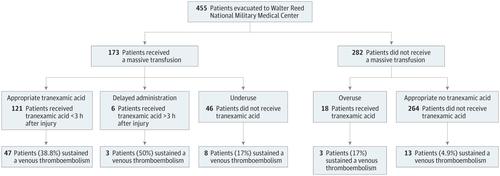JAMA Surgery ( IF 15.7 ) Pub Date : 2018-02-01 , DOI: 10.1001/jamasurg.2017.3821 Luke R. Johnston 1 , Carlos J. Rodriguez 1 , Eric A. Elster 1, 2 , Matthew J. Bradley 1, 2, 3

|
Importance Since publication of the CRASH-2 and MATTERs studies, the US military has included tranexamic acid (TXA) in clinical practice guidelines. While TXA was shown to decrease mortality in trauma patients requiring massive transfusion, improper administration and increased risk of venous thromboembolism remain a concern.
Objective To determine the appropriateness of TXA administration by US military medical personnel based on current Joint Trauma System clinical practice guidelines and to determine if TXA administration is associated with venous thromboembolism.
Design, Setting, and Participants This cohort study of US military casualties in US military combat support hospitals in Afghanistan and a single US-based tertiary military treatment facility within the continental United States was conducted from 2011 to 2015, with follow-up through initial hospitalization and readmissions.
Exposures Data collected for all patients included demographic information as well as Injury Severity Score; receipt of blood products, TXA, and/or a massive transfusion; and admission hemodynamics.
Main Outcomes and Measures Variance from guidelines in TXA administration and venous thromboembolism. Tranexamic acid overuse was defined as a hemodynamically stable patient receiving TXA but not a massive transfusion, underuse was defined as a patient receiving a massive transfusion but not TXA, and TXA administration was considered delayed when given more than 3 hours after injury.
Results Of the 455 identified patients, 443 (97.4%) were male, and the mean (SD) age was 25.3 (4.8) years. A total of 173 patients (38.0%) received a massive transfusion, and 139 (30.5%) received TXA in theater. Overuse occurred in 18 of 282 patients (6.4%) and underuse in 46 of 173 (26.6%) receiving massive transfusions, and delayed administration was found in 6 of 145 patients (4.3%) receiving TXA. Overuse increased at 3.3% per quarter (95% CI, 4.0-9.9; P < .001; R2 = 0.340) and underuse decreased at −4.4% per quarter (95% CI, −4.5 to −3.6; P < .001; R2 = 0.410). Tranexamic acid administration was an independent risk factor for venous thromboembolism (odds ratio, 2.58; 95% CI, 1.20-5.56; P = .02).
Conclusions and Relevance Military medical personnel decreased missed opportunities to appropriately use TXA but also increased overuse. In addition, TXA administration was an independent risk factor for venous thromboembolism. A reevaluation of the use of TXA in combat casualties should be undertaken.
中文翻译:

氨甲环酸及其相关血栓栓塞事件的军事用途评估
重要性 自CRASH-2和MATTERs研究发表以来,美国军方已将氨甲环酸(TXA)纳入临床实践指南。尽管显示TXA可以降低需要大量输血的创伤患者的死亡率,但不当给药和静脉血栓栓塞风险增加仍然是一个问题。
目的 根据目前的联合创伤系统临床实践指南确定美军医务人员进行TXA的适当性,并确定TXA的给药是否与静脉血栓栓塞有关。
设计,地点和参与者 这项队列研究是对2011年至2015年美国在阿富汗的美国军事作战支援医院和美国本土的一家美国第三级军事治疗设施中的美军伤亡进行的研究,并通过初始住院进行随访和重新录取。
为所有患者收集的暴露数据包括人口统计学信息以及损伤严重程度评分;收到血液制品,TXA和/或大量输血;和入院血流动力学。
主要结果和措施 与TXA给药指南和静脉血栓栓塞指南的差异。氨甲环酸过度使用被定义为血液动力学稳定的患者接受TXA但未大量输血,未充分使用定义为患者接受大量输血但未接受TXA,受伤后3小时以上给予TXA给药被认为是延迟的。
结果 在455例确定的患者中,443例(97.4%)为男性,平均(SD)年龄为25.3(4.8)岁。共有173名患者(38.0%)接受了大规模输血,而139名患者(30.5%)在剧院接受了TXA。282例患者中有18例过度使用(6.4%),而173例中46例(26.6%)使用不充分,145例接受TXA的患者中有6例(4.3%)发现给药延迟。过度使用率每季度增加3.3%(95%CI,4.0-9.9; P <.001; R 2 = 0.340),过度使用率每季度降低-4.4%(95%CI,-4.5至-3.6; P <.001 ;R 2 = 0.410)。给予氨甲环酸是静脉血栓栓塞的独立危险因素(比值比为2.58; 95%CI为1.20-5.56;比值为2.5)。P = .02)。
结论与相关性 军事医务人员减少了正确使用TXA的机会,但也增加了过度使用的机会。此外,TXA给药是静脉血栓栓塞的独立危险因素。应该重新评估在战斗伤亡中使用TXA的情况。











































 京公网安备 11010802027423号
京公网安备 11010802027423号